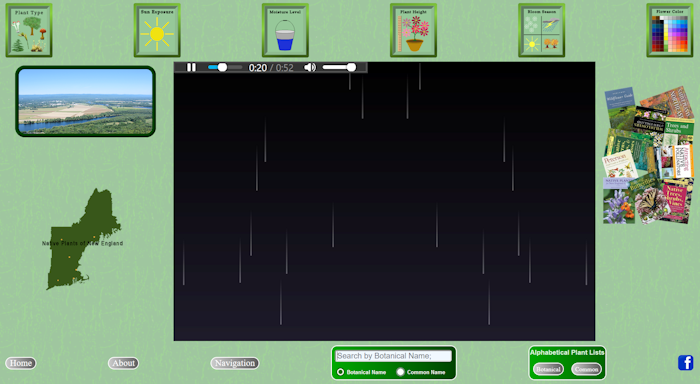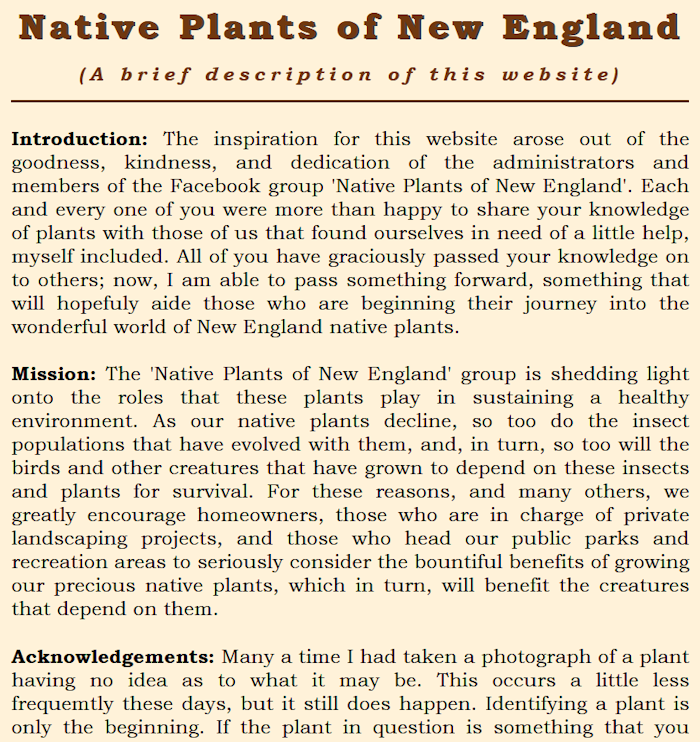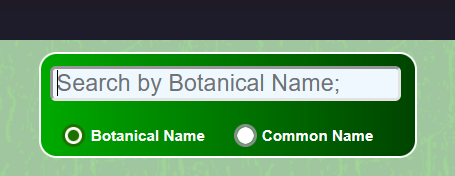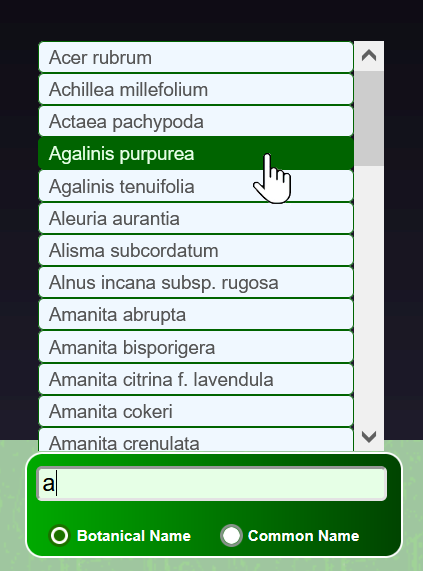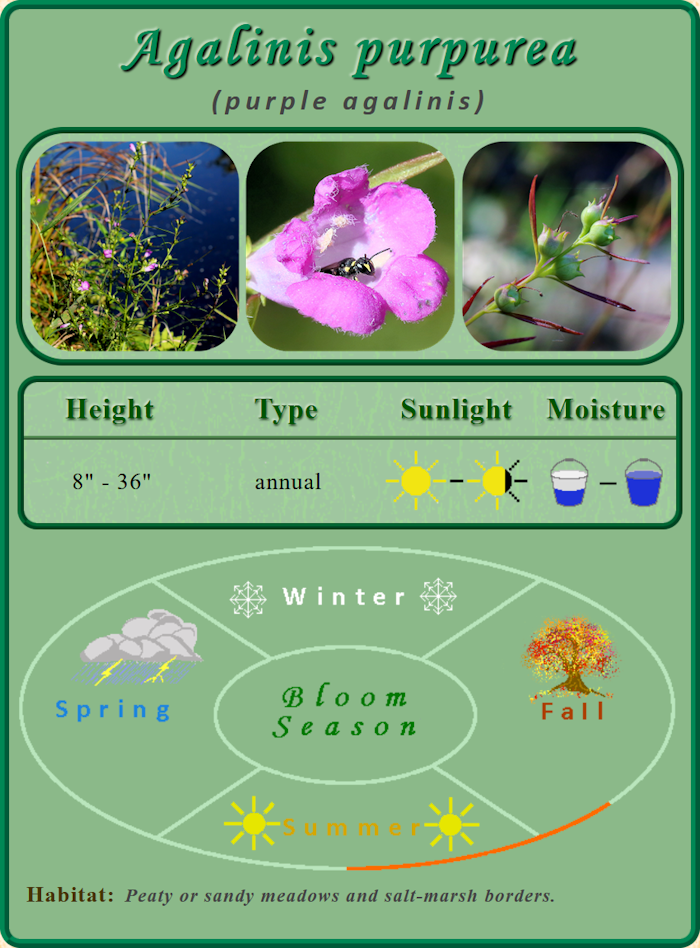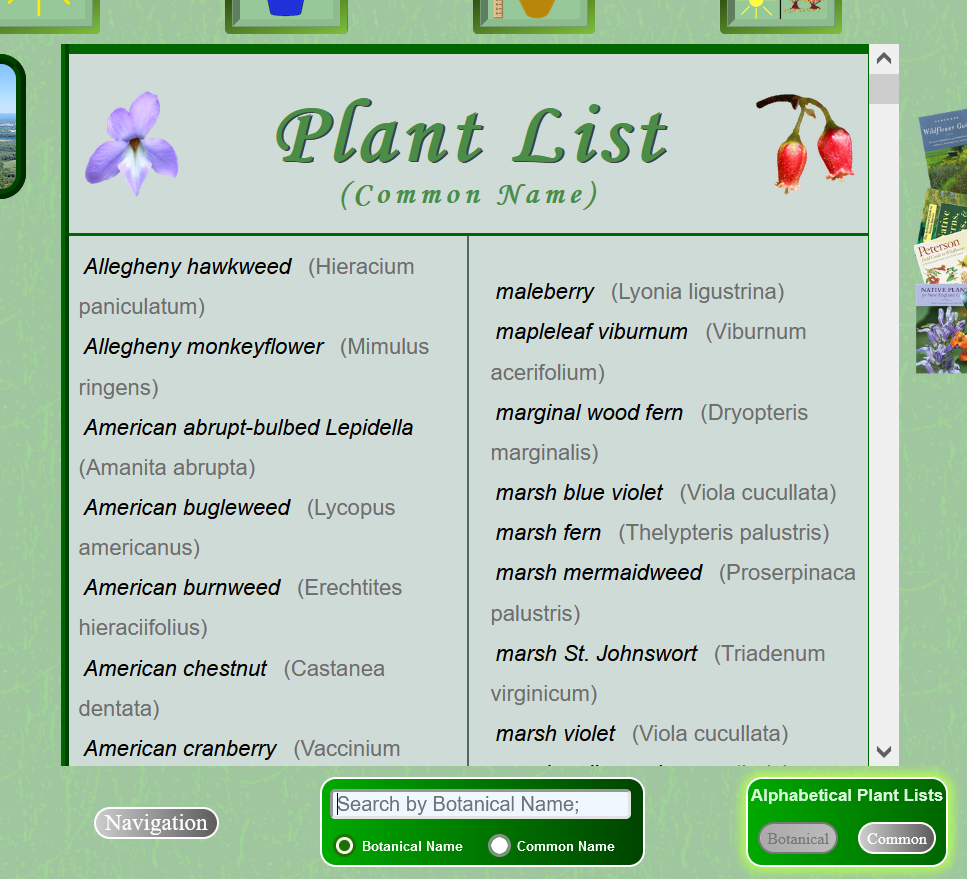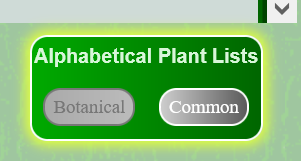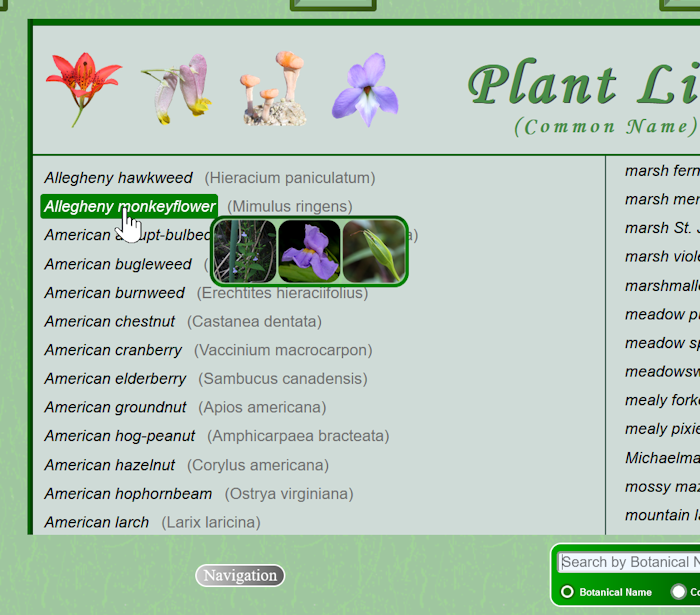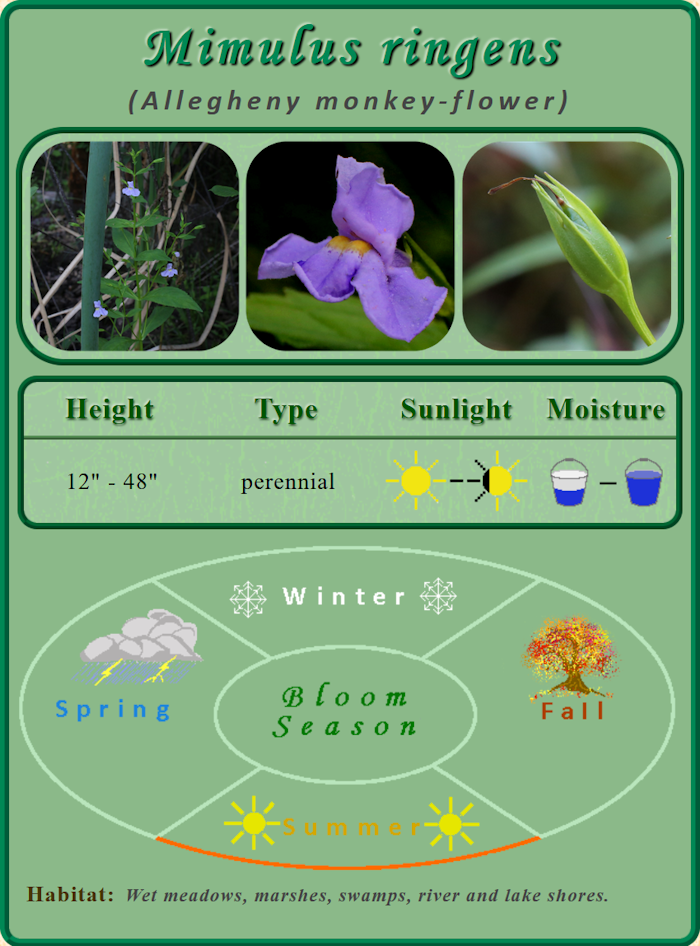Navigation: The Header Navigation bar contains six
clickable Icons. They are:1)Plant Type, 2)Sun Exposure, 3)Moisture Level,
4)Plant Height, 5)Bloom Season, and
6)Flower Color.
contains six
clickable Icons. They are:1)Plant Type, 2)Sun Exposure, 3)Moisture Level,
4)Plant Height, 5)Bloom Season, and
6)Flower Color.
When one of the icons in the header navigation bar is clicked/selected, such as 'Plant Type ', a list of choices will appear on the left side of the screen as a Side Navigation Menu
', a list of choices will appear on the left side of the screen as a Side Navigation Menu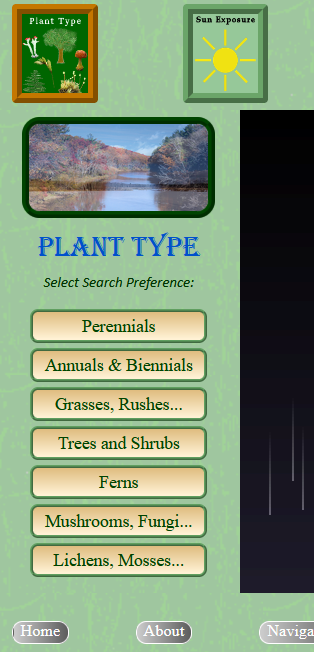 . There will be between four to nine
items to chose from, depending on which of the icons has been selected.
. There will be between four to nine
items to chose from, depending on which of the icons has been selected.
When one of the side navigation menu items is chosen/clicked, in this case 'Perennials', a Group of Photos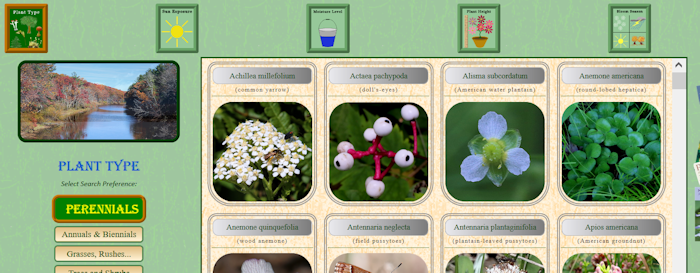 appearing
in alphabetical order by botanical name will be displayed in the center of the page.
appearing
in alphabetical order by botanical name will be displayed in the center of the page.
Within the silver bar, located above every individual plant photo, is the plant's ' Botanical Name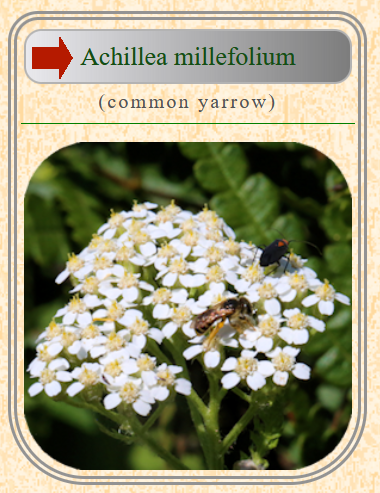 ', aka the latin
name, the one that everyone hates, but is crutial for conveying proper identification. Over time, plants have accumulated many different common names; depending on what part of the world, country, or state that you live in, a
plant could potentially have a different common name in many different locations across the globe. This confusion, created by the use of different names, has often lead to inaccurate plant identifications.
', aka the latin
name, the one that everyone hates, but is crutial for conveying proper identification. Over time, plants have accumulated many different common names; depending on what part of the world, country, or state that you live in, a
plant could potentially have a different common name in many different locations across the globe. This confusion, created by the use of different names, has often lead to inaccurate plant identifications.
A plant's official name conforms to the International Code of Nomenclature whose current version, the Shenzhen Code, was adopted by the International Botanical Congress held in Shenzhen, China, in July 2017, and
its final form was published on June 26, 2018. The use of formal names is meant to prevent potential misunderstandings and misidentification of a plant species.
The silver bar, in which the botanical name resides, is actually a hyperlink
that brings you to a more Detailed Description of the selected plant; in this case, Achillea millefolium has been selected.
of the selected plant; in this case, Achillea millefolium has been selected.
- Plant Type (7 choices): They are:
1)Perennials, 2)Annuals and Biennials, 3)Grasses-Rushes-Sedges,
4)Trees and Shrubs, 5)Ferns, 6)Mushrooms and Fungi,
and 7)Lichens and Mosses.
I took a few liberties with this group, as I often come across mushrooms, polypores, slime molds, and lichens, all of which are not plants...So, what was I to do; I could not just pass these extraordinary life forms by! Somehow, I think it was by magic, they managed to sneak their way into this category.😇
These wonders of nature, as primitive, complex and fascinating as they are, have their very own special appeal; they just beg to be noticed, and deservedly so!
- Sun Exposure (5 choices): The choices are: 1)Full Sun, 2)Mostly Sunny, 3)Medium Sun, 4)Partial Sun, and 5)Full Shade.
Giving your plants the right amount of sun exposure can be quite a tricky endeavor...
If you are on a nature walk and you come across a particular plant that you like, mimic your planting site, to the best of your ability, to that of the plant as it sits in the wild. Take note of the amount of sunlight and moisture that it receives, as well as soil type, if possible. Also, just as important, take notice of the plants that it is growing under and near; there are a great deal of plants that depend on symbiosis for survival.
Symbiosis, by definition, is a close and long-term biological interaction between two different species; that of bees and flowers is probably the best example, but here, I am specifically refering to the interaction between fungi and plants. This particular partnership is called mycorrhizae, which is used by 80% - 90% of all land plants for their survival. In this association, the underground fungi colonize the root system of a host plant, providing increased water and nutrient absorption capabilities while the plant provides the fungus with carbohydrates formed from photosynthesis.
Below, is just a small sample of the untold number of our native flowering plants that use this intriguing survival technique:- Cypripedium acaule (pink lady's slipper)
- Aureolaria pedicularia (fern-leaved false foxglove)
- Monotropa uniflora (Indian pipe)
- Orobanche uniflora (one-flowered cancer-root)
- Melampyrum lineare (cow-wheat)
Back to Sun Exposure: On a sunny day, observe your chosen planting area in half hour increments; this will give you a better understanding of just how much sunlight is available. The time of year that you do your measuring is important; your chosen planting site will look much different in April, when the sun is lower in the sky and the trees have not leafed out yet, than it will in the summer when the sun is high and there is plenty of shade from surrounding trees and shrubs. Also, just as important, remember that morning sun is cooler than afternoon sun; by the time that the afternoon has rolled around, the sun has had a good part of the day to heat up the atmosphere.
Speaking of tricky: trying to determine my sun exposure choices was no picnic! In most of the literature that I read, partial sun and partial shade are interchangeable; how does that make any sense? Then there is 'medium/half shade'; what does that actually mean? And then you throw 'dappled shade' into the mix...all of this confusing info had left me quite perplexed!
In the end, I stuck with the conventional designations for full sun, partial sun, and full shade but added two more categories: mostly sunny and medium sun; I hope these make sense to others?
a) You will find that many plants can overlap sun exposure categories. Plants usually have a preference for their sunlight needs but can handle a little more, or a little less, light. A plant that moves into a little more sun may need additional water, while a plant moving into a little more shade may send out less flowers; some plants are perfectly happy in more than one category.Notes:
b) Plants from the nursery should have a sunlight requirement symbol/icon on them:
c) Dappled shade: I would expect that dappled shade could very well fit into any, or all of these categories, but, I believe it is meant to be a variation of the category, partial sun?
Full Sun - 6 or more hours of sun. 
Partial Sun - 4 to 6 hours of sun. 
Full Shade - 3 hours or less of sun.
- Moisture Level (5 choices): They are: 1)Dry, 2)Light, 3)Medium, 4)Moist, and 5)Wet.
As with 'sun exposure', how much water to give a plant and when to give it water can be a delicate balancing act; replicating the plant's natural habitat as closely as possible is always the best way to go.
In my research, the triad of terms xeric(of an environment or habitat) containing little moisture; very dry., mesic(of an environment or habitat) containing a moderate or well-balanced supply of moisture, and hydric(of an environment or habitat) containing plenty of moisture; very wet. were regularly used to describe the amount of water in a habitat. This may be over simplifying things, but I think that these are just a fancy way of saying dry, medium, and wet. I was not completely satisfied with these three conventional moisture categories so I added two others: light and moist.
a) Also, as with 'sun exposure', some plants can be happy in more than one moisture category. When taking a plant away from its prefered moisture needs, drainage, or the lack of, and the amount of sun exposure, will more than likely be the key to its survival.Notes:
b) Plants from the nursery should have a moisture requirement symbol/icon on them:
c) Determining if your soil is moist is a pretty straight forward endeavor. You can either:💧 = Dry💧 💧 = Medium💧 💧 💧 = Wet- Stick your finger into the soil, down to the second knuckle
- Stick a dry dowel into the soil; the dowel will turn a darker color, and soil will stick to it if there is moisture present
- or you can buy a moisture meter; they come in a wide range of prices
- Sun Exposure (5 choices): The choices are: 1)Full Sun, 2)Mostly Sunny, 3)Medium Sun, 4)Partial Sun, and 5)Full Shade.
- Plant Height
(8 choices): They are:
1)Under 1', 2)1' - 2', 3) 2' - 3', 4)3' - 4',
5)4' - 6', 6)6' - 10', 7)10' - 30',
and 8)Over 30'.
Here, probably more than in any other category, there can be a great deal of over-lap. Many factors can alter a plant's height such as: habitat, soil type, moisture content, and sun exposure, just to name a few. For example, take a look at our beloved Eupatorium perfoliatum (common boneset), which can grow between 1' to 5' in height, depending on the afore mentioned factors.
So, please keep in mind that my listings are just a general guideline and that chosing your plants carefully may still result in one that may turn out to be a bit taller, or shorter, than expected; don't shoot the messenger; that's nature for you! 🤕 - Bloom Season
(8 choices): They are:
1)Late Winter,
2)Early Spring, 3)Mid Spring, 4)Late Spring, 5)Early Summer,
6)Mid Summer, 7)Late Summer, and 8)Fall.
Important! When viewing a plant's bloom season on this site, as well as most other websites for that matter, there is one thing that you should keep in mind: first, and foremost, the bloom season that is depicted represents the time at which a plant may flower over the entirety of its native range...This should not be confused with its time in flower. If you research a plant, which I strongly suggest that you do, you will often come across a phrase such as this, "The blooming period occurs during late spring to early summer and lasts about 2-3 weeks." Here, the reader is being informed that this particular plant will flower for about 15 to 20 days, anywhere from early/mid May to late June/Early July, depending on where you live. I felt that I had an obligation to my readers to try and clarify this often over-looked, and often misunderstood, piece of information. The fact is, the majority of our flowering plants bloom for roughly two to three weeks, not for several months. There are some plants, such as Apocynum cannabinum (Indian hemp), Euthamia graminifolia (flat-top goldentop, grass-leaved goldenrod), and some others that flower for a month or more, but for the most part, they are the exception rather than the rule.
Bloom season is a hard category to pin down because there are so many factors that can alter the time at which a plant will flower; the most noteworthy of these being your Hardiness Zone ...not to be confused with 'Climate Zone
...not to be confused with 'Climate Zone
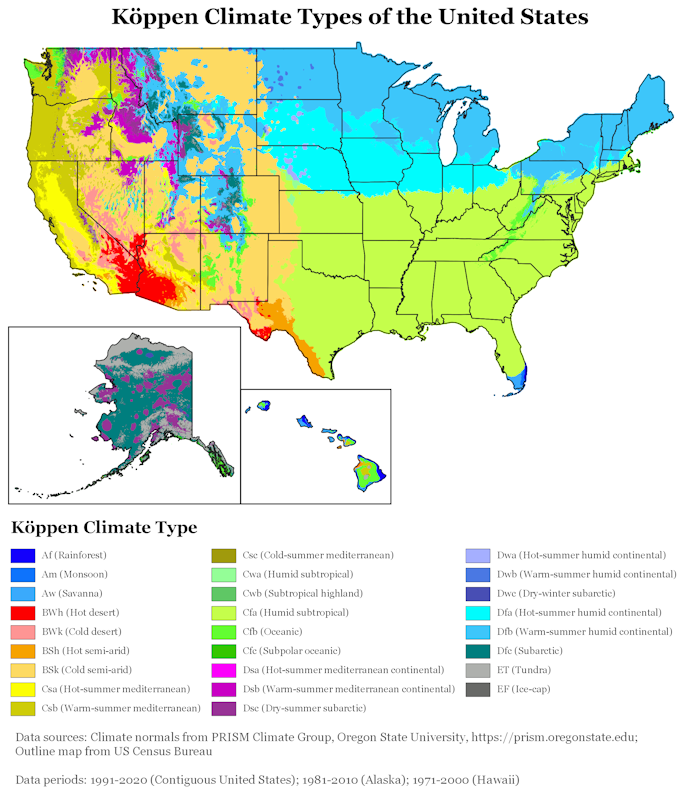 '. The weather, be it hot, cold, wet, or dry, especially for extended periods, will also affect flowering time, as will the creation of micro climates within your comunity, or
even your own yard. Also, a stressed or damaged plant, whether it's from insects, man, weather, or something else, can trigger a plant into activating its flowering process.
'. The weather, be it hot, cold, wet, or dry, especially for extended periods, will also affect flowering time, as will the creation of micro climates within your comunity, or
even your own yard. Also, a stressed or damaged plant, whether it's from insects, man, weather, or something else, can trigger a plant into activating its flowering process.
Taking all of this into account, I did my best with determining a plants 'Bloom Season'. Since New England is represented by several hardiness zones, your plant's bloom season will depend, for the most part, on your location. The plant photos displayed within this site were taken in and around my area of MA , which is on the border of zones 5 and 6. It has
reached -14°F here at my home a couple of times over the past decade, so I urge you to err on the side of caution when chosing plants that are on the borderline of your cold hardiness zone.
, which is on the border of zones 5 and 6. It has
reached -14°F here at my home a couple of times over the past decade, so I urge you to err on the side of caution when chosing plants that are on the borderline of your cold hardiness zone.
- Flower Color
(9 choices): They are:
1)White, 2)Yellow, 3)Orange, 4)Purple,
5)Blue, 6)Pink, 7)Red, 8)Green,
and 9)Brown.
I thought that creating this category was going to be an easy task; after all, how hard can it be to choose colors? Well, I thought wrong; as my wife would say, "Don't ever give a man too many choices!"🤯
The flowers entered into the White category were fairly easy to dertermine, as were those for the colors of Brown and Green, but after that... The party was over!Here was my dilemma: Where do you draw the line between the colors of yellow and orange? Or orange and red? And then there is red and pink. And pink and purple. And we cannot forget about purple and blue. All of this was giving me a headache and messing with my eyes, and then I thought to myself, "What about the multi-colored flowers!"😵
In any event, once I regained some semblence of my former sanity, I broke my list down to 9 color choices, and wouldn't you know it; according to my computer's paint program, I'm only a mere 16,777,207 colors shy of the possible color choices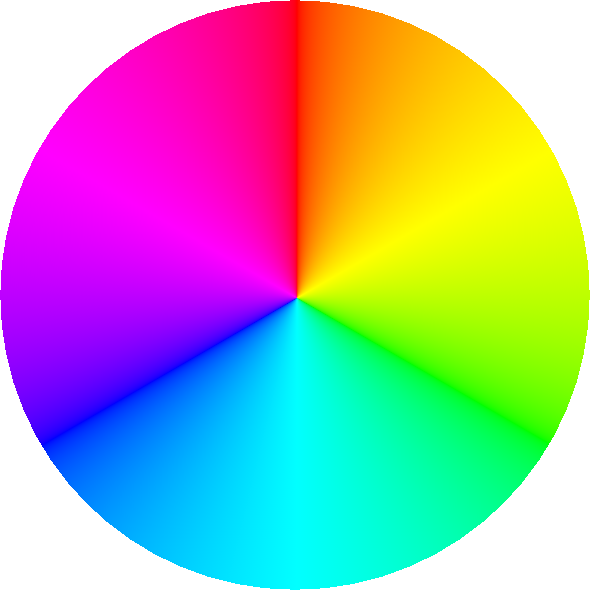 .🥴
.🥴
In short, when searching for your flowers "by color", on this site, keep a couple of things in mind:
- If I came across a plant whose flowers were somewhere in between two of my color choices, or they were multi-colored flowers, I put the plant into all of the possible color choices for that particular plant.
- A flower may have the appearance of a different color when it resides in shade as opposed to being in bright sunlight; some also change colors as they age; in these cases, I also put the plant into all applicable categories.
Good Luck!

